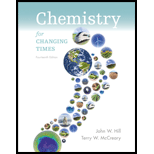
Chemistry for Changing Times
14th Edition
ISBN: 9780134212777
Author: John W. Hill; Terry W. McCreary
Publisher: Pearson Education (US)
expand_more
expand_more
format_list_bulleted
Question
Chapter 20, Problem 5CHQ
Interpretation Introduction
Interpretation: The reason to consider making your own herbicide instead of buying a synthetic weed killer.
Concept Introduction: Strong weed killers attack the root of the weeds. It travels down the root to the underground system of the weed, and prevents it from growing thus killing the weed systematically from inside out. Some strong weed killers may be slow to act but they are perfect for killing difficult and perennial weeds. After application of the weed killer, the weed control takes 7 to 10 days to show its result. Many weed killers are rendered ineffective die to rain as they tend to get washed away.
Expert Solution & Answer
Want to see the full answer?
Check out a sample textbook solution
Students have asked these similar questions
>
You are trying to decide if there is a single reagent you can add that will make the following synthesis possible without any other
major side products:
1. ☑
CI
2. H3O+
O
Draw the missing reagent X you think will make this synthesis work in the drawing area below.
If there is no reagent that will make your desired product in good yield or without complications, just check the box under the
drawing area and leave it blank.
Click and drag to start drawing a
structure.
Explanation
Check
?
DO
18
Ar
B
© 2025 McGraw Hill LLC. All Rights Reserved. Terms of Use | Privacy Center | Accessibility
Don't use ai to answer I will report you answer
Consider a solution of 0.00304 moles of 4-nitrobenzoic acid (pKa = 3.442) dissolved in 25 mL water and titrated with 0.0991 M NaOH. Calculate the pH at the equivalence point
Chapter 20 Solutions
Chemistry for Changing Times
Ch. 20 - Prob. 1RQCh. 20 - Prob. 2RQCh. 20 - Prob. 3RQCh. 20 - Prob. 4RQCh. 20 - Prob. 5RQCh. 20 - What are the primary challenges in feeding an...Ch. 20 - Prob. 7PCh. 20 - Prob. 8PCh. 20 - Prob. 9PCh. 20 - Prob. 10P
Ch. 20 - Prob. 11PCh. 20 - Prob. 12PCh. 20 - Prob. 13PCh. 20 - Prob. 14PCh. 20 - Prob. 15PCh. 20 - Prob. 16PCh. 20 - Prob. 17PCh. 20 - Prob. 18PCh. 20 - Prob. 19PCh. 20 - Prob. 20PCh. 20 - Prob. 21PCh. 20 - Prob. 22PCh. 20 - Prob. 23PCh. 20 - Prob. 24PCh. 20 - Prob. 25PCh. 20 - Prob. 26PCh. 20 - Prob. 27PCh. 20 - Prob. 28PCh. 20 - Prob. 29PCh. 20 - Prob. 30PCh. 20 - Prob. 31PCh. 20 - Prob. 32PCh. 20 - Prob. 33APCh. 20 - Prob. 34APCh. 20 - Prob. 35APCh. 20 - Prob. 36APCh. 20 - Prob. 37APCh. 20 - Prob. 38APCh. 20 - Prob. 39APCh. 20 - Prob. 40APCh. 20 - Prob. 41APCh. 20 - Prob. 42APCh. 20 - Prob. 43APCh. 20 - Prob. 44APCh. 20 - Prob. 45APCh. 20 - Prob. 46APCh. 20 - Prob. 47APCh. 20 - Prob. 48APCh. 20 - Prob. 49APCh. 20 - Prob. 20.1CTECh. 20 - Prob. 20.2CTECh. 20 - Prob. 20.3CTECh. 20 - Prob. 20.4CTECh. 20 - Prob. 20.5CTECh. 20 - A newspaper article suggests, “Try out tobacco...Ch. 20 - Prepare a PowerPoint, poster. or other...Ch. 20 - Prob. 2CGPCh. 20 - Prob. 3CGPCh. 20 - Prob. 4CGPCh. 20 - Prob. 5CGPCh. 20 - Prob. 6CGPCh. 20 - Prob. 7CGPCh. 20 - Prob. 8CGPCh. 20 - Prob. 1CHQCh. 20 - Prob. 2CHQCh. 20 - Prob. 3CHQCh. 20 - Prob. 4CHQCh. 20 - Prob. 5CHQ
Knowledge Booster
Similar questions
- What is the name of the following compound? SiMe3arrow_forwardK Draw the starting structure that would lead to the major product shown under the provided conditions. Drawing 1. NaNH2 2. PhCH2Br 4 57°F Sunny Q Searcharrow_forward7 Draw the starting alkyl bromide that would produce this alkyne under these conditions. F Drawing 1. NaNH2, A 2. H3O+ £ 4 Temps to rise Tomorrow Q Search H2arrow_forward
arrow_back_ios
SEE MORE QUESTIONS
arrow_forward_ios
Recommended textbooks for you
 ChemistryChemistryISBN:9781305957404Author:Steven S. Zumdahl, Susan A. Zumdahl, Donald J. DeCostePublisher:Cengage Learning
ChemistryChemistryISBN:9781305957404Author:Steven S. Zumdahl, Susan A. Zumdahl, Donald J. DeCostePublisher:Cengage Learning ChemistryChemistryISBN:9781259911156Author:Raymond Chang Dr., Jason Overby ProfessorPublisher:McGraw-Hill Education
ChemistryChemistryISBN:9781259911156Author:Raymond Chang Dr., Jason Overby ProfessorPublisher:McGraw-Hill Education Principles of Instrumental AnalysisChemistryISBN:9781305577213Author:Douglas A. Skoog, F. James Holler, Stanley R. CrouchPublisher:Cengage Learning
Principles of Instrumental AnalysisChemistryISBN:9781305577213Author:Douglas A. Skoog, F. James Holler, Stanley R. CrouchPublisher:Cengage Learning Organic ChemistryChemistryISBN:9780078021558Author:Janice Gorzynski Smith Dr.Publisher:McGraw-Hill Education
Organic ChemistryChemistryISBN:9780078021558Author:Janice Gorzynski Smith Dr.Publisher:McGraw-Hill Education Chemistry: Principles and ReactionsChemistryISBN:9781305079373Author:William L. Masterton, Cecile N. HurleyPublisher:Cengage Learning
Chemistry: Principles and ReactionsChemistryISBN:9781305079373Author:William L. Masterton, Cecile N. HurleyPublisher:Cengage Learning Elementary Principles of Chemical Processes, Bind...ChemistryISBN:9781118431221Author:Richard M. Felder, Ronald W. Rousseau, Lisa G. BullardPublisher:WILEY
Elementary Principles of Chemical Processes, Bind...ChemistryISBN:9781118431221Author:Richard M. Felder, Ronald W. Rousseau, Lisa G. BullardPublisher:WILEY

Chemistry
Chemistry
ISBN:9781305957404
Author:Steven S. Zumdahl, Susan A. Zumdahl, Donald J. DeCoste
Publisher:Cengage Learning

Chemistry
Chemistry
ISBN:9781259911156
Author:Raymond Chang Dr., Jason Overby Professor
Publisher:McGraw-Hill Education

Principles of Instrumental Analysis
Chemistry
ISBN:9781305577213
Author:Douglas A. Skoog, F. James Holler, Stanley R. Crouch
Publisher:Cengage Learning

Organic Chemistry
Chemistry
ISBN:9780078021558
Author:Janice Gorzynski Smith Dr.
Publisher:McGraw-Hill Education

Chemistry: Principles and Reactions
Chemistry
ISBN:9781305079373
Author:William L. Masterton, Cecile N. Hurley
Publisher:Cengage Learning

Elementary Principles of Chemical Processes, Bind...
Chemistry
ISBN:9781118431221
Author:Richard M. Felder, Ronald W. Rousseau, Lisa G. Bullard
Publisher:WILEY